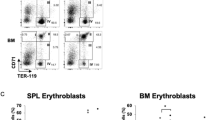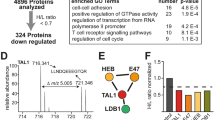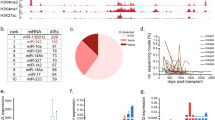Abstract
MicroRNAs (miRNAs) are a class of small regulatory noncoding RNAs that modulate the expression of their target genes through either mRNA degradation or inhibition of protein translation. In recent years, miRNAs have been shown to be critical regulators of hematopoiesis and have important roles in the differentiation of specific lineages. Here, we summarize our current understanding of miRNAs involved in hematopoiesis with a focus on the role of miRNAs in regulating erythroid and megakaryocytic differentiation and megakaryocyte–erythroid progenitor lineage commitment.
This is a preview of subscription content, access via your institution
Access options
Subscribe to this journal
Receive 12 print issues and online access
$259.00 per year
only $21.58 per issue
Buy this article
- Purchase on Springer Link
- Instant access to full article PDF
Prices may be subject to local taxes which are calculated during checkout

Similar content being viewed by others
References
Orkin SH, Zon LI . Hematopoiesis: an evolving paradigm for stem cell biology. Cell 2008; 132: 631–644.
Iwasaki H, Akashi K . Myeloid lineage commitment from the hematopoietic stem cell. Immunity 2007; 26: 726–740.
Laiosa CV, Stadtfeld M, Graf T . Determinants of lymphoid-myeloid lineage diversification. Ann Rev Immunol 2006; 24: 705–738.
Kim SI, Bresnick EH . Transcriptional control of erythropoiesis: emerging mechanisms and principles. Oncogene 2007; 26: 6777–6794.
Bartel DP . MicroRNAs: target recognition and regulatory functions. Cell 2009; 136: 215–233.
Guo H, Ingolia N, Weissman J, Bartel D . Mammalian microRNAs predominantly act to decrease target mRNA levels. Nature 2010; 466: 835–840.
Bartel DP, Chen CZ . Micromanagers of gene expression: the potentially widespread influence of metazoan microRNAs. Nat Rev 2004; 5: 396–400.
Chen CZ, Li L, Lodish HF, Bartel DP . MicroRNAs modulate hematopoietic lineage differentiation. Science 2004; 303: 83–86.
Zhao G, Yu D, Weiss MJ . MicroRNAs in erythropoiesis. Curr Opin Hematol 2010; 17: 155–162.
Byon JC, Papayannopoulou T . MicroRNAs: allies or foes in erythropoiesis? J Cell Physiol 2012; 227: 7–13.
Kondo M, Weissman IL, Akashi K . Identification of clonogenic common lymphoid progenitors in mouse bone marrow. Cell 1997; 91: 661–672.
Akashi K, Traver D, Miyamoto T, Weissman IL . A clonogenic common myeloid progenitor that gives rise to all myeloid lineages. Nature 2000; 404: 193–197.
Na Nakorn T, Traver D, Weissman IL, Akashi K . Myeloerythroid-restricted progenitors are sufficient to confer radioprotection and provide the majority of day 8 CFU-S. J Clin Invest 2002; 109: 1579–1585.
Adolfsson J, Mansson R, Buza-Vidas N, Hultquist A, Liuba K, Jensen CT et al. Identification of Flt3+ lympho-myeloid stem cells lacking erythro-megakaryocytic potential a revised road map for adult blood lineage commitment. Cell 2005; 121: 295–306.
Forsberg EC, Serwold T, Kogan S, Weissman IL, Passegue E . New evidence supporting megakaryocyte-erythrocyte potential of flk2/flt3+ multipotent hematopoietic progenitors. Cell 2006; 126: 415–426.
Subramanyam D, Lamouille S, Judson RL, Liu JY, Bucay N, Derynck R et al. Multiple targets of miR-302 and miR-372 promote reprogramming of human fibroblasts to induced pluripotent stem cells. Nat Biotechnol 2011; 29: 443–448.
Anokye-Danso F, Trivedi CM, Juhr D, Gupta M, Cui Z, Tian Y et al. Highly efficient miRNA-mediated reprogramming of mouse and human somatic cells to pluripotency. Cell stem cell 2011; 8: 376–388.
Lodish H, Flygare J, Chou S . From stem cell to erythroblast: Regulation of red cell production at multiple levels by multiple hormones. IUBMB Life 2010; 62: 492–496.
Richmond T, Chohan M, Barber D . Turning cells red: signal transduction mediated by erythropoietin. Trends Cell Biol 2005; 15: 146–155.
Dore LC, Amigo JD, Dos Santos CO, Zhang Z, Gai X, Tobias JW et al. A GATA-1-regulated microRNA locus essential for erythropoiesis. Proc Natl Acad Sci USA 2008; 105: 3333–3338.
Pase L, Layton JE, Kloosterman WP, Carradice D, Waterhouse PM, Lieschke GJ . miR-451 regulates zebrafish erythroid maturation in vivo via its target gata2. Blood 2009; 113: 1794–1804.
Fu YF, Du TT, Dong M, Zhu KY, Jing CB, Zhang Y et al. Mir-144 selectively regulates embryonic alpha-hemoglobin synthesis during primitive erythropoiesis. Blood 2009; 113: 1340–1349.
Rasmussen KD, Simmini S, Abreu-Goodger C, Bartonicek N, Di Giacomo M, Bilbao-Cortes D et al. The miR-144/451 locus is required for erythroid homeostasis. J Exp Med 2010; 207: 1351–1358.
Yu D, dos Santos CO, Zhao G, Jiang J, Amigo JD, Khandros E et al. miR-451 protects against erythroid oxidant stress by repressing 14-3-3zeta. Genes Dev 2010; 24: 1620–1633.
Patrick DM, Zhang CC, Tao Y, Yao H, Qi X, Schwartz RJ et al. Defective erythroid differentiation in miR-451 mutant mice mediated by 14-3-3zeta. Genes Dev 2010; 24: 1614–1619.
Cheloufi S, Dos Santos CO, Chong MM, Hannon GJ . A dicer-independent miRNA biogenesis pathway that requires Ago catalysis. Nature 2010; 465: 584–589.
Felli N, Fontana L, Pelosi E, Botta R, Bonci D, Facchiano F et al. MicroRNAs 221 and 222 inhibit normal erythropoiesis and erythroleukemic cell growth via kit receptor down-modulation. Proc Natl Acad Sci USA 2005; 102: 18081–18086.
Wang Q, Huang Z, Xue H, Jin C, Ju XL, Han JD et al. MicroRNA miR-24 inhibits erythropoiesis by targeting activin type I receptor ALK4. Blood 2008; 111: 588–595.
Zhao H, Kalota A, Jin S, Gewirtz AM . The c-myb proto-oncogene and microRNA-15a comprise an active autoregulatory feedback loop in human hematopoietic cells. Blood 2009; 113: 505–516.
Sankaran VG, Menne TF, Šćepanović D, Vergilio JA, Ji P, Kim J et al. MicroRNA-15a and -16-1 act via MYB to elevate fetal hemoglobin expression in human trisomy 13. Proc Natl Acad Sci USA 2011; 108: 1519–1524.
Sankaran VG, Xu J, Orkin SH . Advances in the understanding of haemoglobin switching. Br J Haematol 2010; 149: 181–194.
Guglielmelli P, Tozzi L, Bogani C, Iacobucci I, Ponziani V, Martinelli G et al. Overexpression of microRNA-16-2 contributes to the abnormal erythropoiesis in polycythemia vera. Blood 2011; 117: 6923–6927.
Zhang L, Flygare J, Wong P, Lim B, Lodish HF . miR-191 regulates mouse erythroblast enucleation by down-regulating Riok3 and Mxi1. Genes Dev 2011; 25: 119–124.
Schreiber-Agus N, DePinho R . Repression by the Mad(Mxi1)-Sin3 complex. Bioessays 1998; 20: 808–818.
Jayapal S, Lee K, Ji P, Kaldis P, Lim B, Lodish H . Downregulation of MYC is essential for terminal erythroid maturation. J Biol Chem 2010; 285: 40252–40265.
Deutsch VR, Tomer A . Megakaryocyte development and platelet production. Br J Haematol 2006; 134: 453–466.
Kaushansky K . The molecular mechanisms that control thrombopoiesis. J Clin Invest 2005; 115: 3339–3347.
Kirito K, Kaushansky K . Transcriptional regulation of megakaryopoiesis: thrombopoietin signaling and nuclear factors. Curr Opin Hematol 2006; 13: 151–156.
Lu J, Guo S, Ebert BL, Zhang H, Peng X, Bosco J et al. MicroRNA-mediated control of cell fate in megakaryocyte-erythrocyte progenitors. Dev Cell 2008; 14: 843–853.
Klusmann JH, Li Z, Böhmer K, Maroz A, Koch ML, Emmrich S et al. miR-125b-2 is a potential oncomiR on human chromosome 21 in megakaryoblastic leukemia. Genes Dev 2010; 24: 478–490.
Ooi AG, Sahoo D, Adorno M, Wang Y, Weissman IL, Park CY . MicroRNA-125b expands hematopoietic stem cells and enriches for the lymphoid-balanced and lymphoid-biased subsets. Proc Natl Acad Sci USA 2010; 107: 21505–21510.
Bousquet M, Quelen C, Rosati R, Mansat-De Mas V, La Starza R, Bastard C et al. Myeloid cell differentiation arrest by miR-125b-1 in myelodysplastic syndrome and acute myeloid leukemia with the t(2;11)(p21;q23) translocation. J Exp Med 2008; 205: 2499–2506.
Bousquet M, Harris MH, Zhou B, Lodish HF . MicroRNA miR-125b causes leukemia. Proc Natl Acad Sci USA 2010; 107: 21558–21563.
Chapiro E, Russell LJ, Struski S, Cavé H, Radford-Weiss I, Valle VD et al. A new recurrent translocation t(11;14)(q24;q32) involving IGH@ and miR-125b-1 in B-cell progenitor acute lymphoblastic leukemia. Leukemia 2010; 24: 1362–1364.
Sonoki T, Iwanaga E, Mitsuya H, Asou N . Insertion of microRNA-125b-1, a human homologue of lin-4, into a rearranged immunoglobulin heavy chain gene locus in a patient with precursor B-cell acute lymphoblastic leukemia. Leukemia 2005; 19: 2009–2010.
Ebert BL, Pretz J, Bosco J, Chang CY, Tamayo P, Galili N et al. Identification of RPS14 as a 5q- syndrome gene by RNA interference screen. Nature 2008; 451: 335–339.
Starczynowski DT, Kuchenbauer F, Argiropoulos B, Sung S, Morin R, Muranyi A et al. Identification of miR-145 and miR-146a as mediators of the 5q- syndrome phenotype. Nat Med 2010; 16: 49–58.
Kumar MS, Narla A, Nonami A, Mullally A, Dimitrova N, Ball B et al. Coordinate loss of a microRNA and protein-coding gene cooperate in the pathogenesis of 5q- syndrome. Blood 2011; 118: 4666–4673.
Labbaye C, Spinello I, Quaranta MT, Pelosi E, Pasquini L, Petrucci E et al. A three-step pathway comprising PLZF/miR-146a/CXCR4 controls megakaryopoiesis. Nat Cell Biol 2008; 10: 788–801.
Hattangadi SM, Wong P, Zhang L, Flygare J, Lodish HF . From stem cell to red cell: regulation of erythropoiesis at multiple levels by multiple proteins, RNAs, and chromatin modifications. Blood 2011; 118: 6258–6268.
Acknowledgements
LZ was supported by a graduate fellowship from the Singapore-Massachusetts Institute of Technology Alliance. VGS received support from NIH grant T32HL007574-30 and funds provided by the Department of Medicine at the Children’s Hospital Boston. This work was supported by SMA grant C-382-641-001-091 (to HFL), and NIH grants DK047618, DK068348 and 5P01 HL066105 (to HFL).
Author information
Authors and Affiliations
Corresponding author
Ethics declarations
Competing interests
The authors declare no conflict of interest.
Rights and permissions
About this article
Cite this article
Zhang, L., Sankaran, V. & Lodish, H. MicroRNAs in erythroid and megakaryocytic differentiation and megakaryocyte–erythroid progenitor lineage commitment. Leukemia 26, 2310–2316 (2012). https://doi.org/10.1038/leu.2012.137
Received:
Revised:
Accepted:
Published:
Issue Date:
DOI: https://doi.org/10.1038/leu.2012.137
Keywords
This article is cited by
-
Insight into microRNAs’ involvement in hematopoiesis: current standing point of findings
Stem Cell Research & Therapy (2023)
-
Targeting Genetic Modifiers of HBG Gene Expression in Sickle Cell Disease: The miRNA Option
Molecular Diagnosis & Therapy (2022)
-
Human m6A-mRNA and lncRNA epitranscriptomic microarray reveal function of RNA methylation in hemoglobin H-constant spring disease
Scientific Reports (2021)
-
Overexpression of miR-669m inhibits erythroblast differentiation
Scientific Reports (2020)
-
Systemic Inflammation and Myelofibrosis in a Patient with Takenouchi-Kosaki Syndrome due to CDC42 Tyr64Cys Mutation
Journal of Clinical Immunology (2020)



